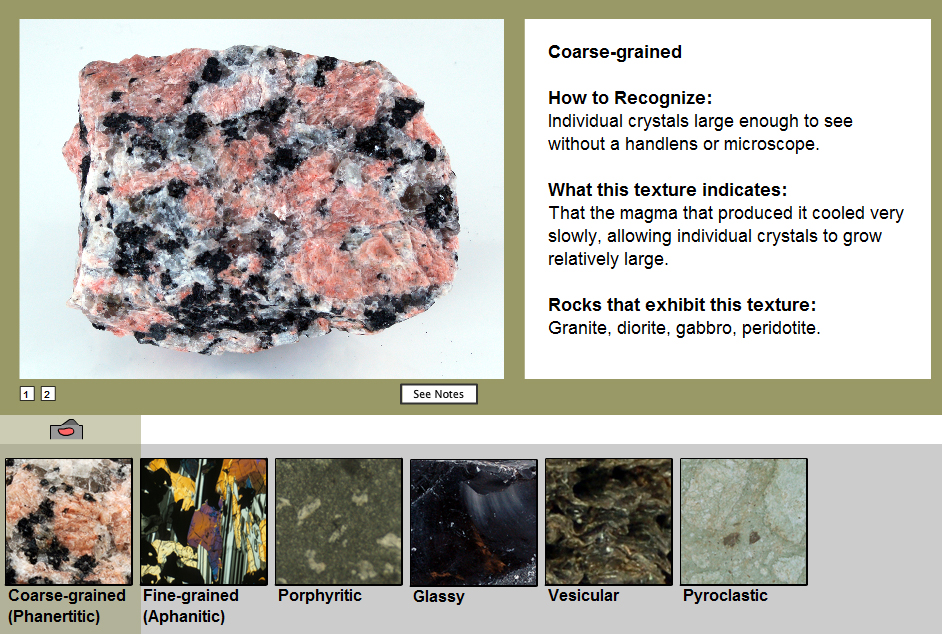
Soon, you should be able to identify your mystery rock and describe it in detail. Unearth the first description you wrote for your mystery rock. Has your expert analysis of the rock changed?
Here's the worksheet for Stations 4E-7C.
How much do you remember about rocks and minerals? We hope lots! - the Earthlings
p.s. Questions are in BLUE. Links are in ORANGE.
Observe each object at this station and decide whether it is a rock or not.
Base your decision on the definition of "rock."
For your science notebook:
1a. Make a list of the objects at this station and write down whether it is a "Rock" or "Not a rock."
1b. Explain in writing why each object that is "Not a rock" is not a rock.
1.1 An orange
1.2 Sea glass
1.3 Diorite
1.4 Conglomerate
1.5 Plastic ball with speckles inside
1.6 Concrete
1.7 Sand
1.8 Obsidian

A rock may be composed of glass rather than mineral matter.

"The Earth is made of rocks that we use for everyday purposes. Get to know them thank you."
- the Earthlings
Observe each rock and decide whether it is igneous in origin. Base your decision on what you already know about igneous rocks.
You'll look at these later and see how much you've learned!
For your science notebook:
2a. Make a list and write down why each of these rocks is, or is not, igneous in origin.
2.1 Rock 1
2.2 Rock 2
2.3 Rock 3
2.4 Rock 4
2.5 Rock 5
2.6 Rock 6
2.7 Rock 7
How igneous rocks form

Igneous rocks can solidify:
1) while underground,
2) after erupting to the surface, or
3) partially at each place, while below and above ground.
Erupted materials include:
1) Lava - molten rock
2) Rocks that were already solid
3) Ash - powedery fine pieces of rockh
3) Gases - carbon dioxide and water
- the Earthlings

"Don't think you know enough to say? And you dont' want to pretend to know.
This is for practice It's ok to guess. We would do it.
A little secret - everyone on Earth starts out that way, without a clue. Even the experts!
Your personal rock will speak to you soon.
- the Earthlings
Observe each set of rocks and objects and explore how atoms, crystals, minerals and rocks are related.
Crystals vs. minerals in a rock
For your science notebook:
3A.a Which sample has the fewest number of crystals?
3A.b Which sample has the greatest number of crystals?
3A.c How many types of minerals are in Sample #2?
3A.d About how many crystals are in Sample #1?
3A.e Which sample has the greatest number of minerals?
Link:
How and where mineral crystals grow as igneous rocks form.
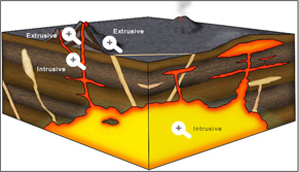
Link:
Two adjacent crystals of the same type.
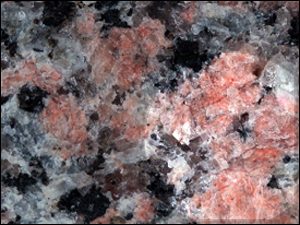
Samples at this station:
3A.1 Pegmatite
3A.2 Diorite
3A.3 Basalt
3A.4 Potassium feldspar
 :
:
"Each speckle in an igneous rock is an individual crystal.
Solid crystals form out of liquid magma as it cools, sort of like ice forming out of water in a freezer.
Crystals start small and grow bigger from the inside out to their finished size. They grow of the the water and magma itself so that after they form, there is no liquid water or magma left.
In a rock, speckles that look the same are made up of the same type of mineral. These crystal speckless grew in a magma or lava as it cooled.
After magma and lava become totally cool, crystals grow and begin to run out of space. They form an interlocking pattern.
- the Earthlings
Atoms that make up minerals
For your science notebook:
3B.a What's the smallest thing you can think of?
Atoms are probably smaller than anything you can imagine. Are you made of atoms?
3B.b Observe Sample #1, the mineral called halite, and describe the shape of the individual halite crystals. Use the hand lens to take a good look.
Halite is the mineral name for everyday table salt.
3B.c Observe the online 3-D model of halite and build your own model using the available parts.
Rotate the online 3-D model by dragging your cursor over the image. Take a good look and figure out the pattern in which the atoms are arranged.
The purple and green spheres represent (stand for) atoms of sodium (Na for short) and chlorine (Cl for short).
To be called the mineral halite, the atoms inside it must be sodium and chloride, and they have to be arranged in this pattern. When you snack on a salty treat, you're consuming these atoms.
3B.d Do you think that the shape of halite crystals are related to the pattern of the atoms inside? Write down what you think.
Links to online 3-D models of atoms in minerals:
Samples at this station:
3B.2 Atoms in halite
3B.3 Silica tetrahedra
 :
:
"EVERYTHING is made up of atoms, not just rocks.
Gold is a type of atom. Since humans love atoms like gold, they are fascinated by rocks that contain it!
Atoms are very, very, tiny. You can't even see them with a microscope. How we even know they exist is something you'll learn about much later.
- Tip from the Earthlings

"Think about the best way to show a 3-D structure on a 2-D piece of paper. A structure is not just a shape, but the arrangement of parts that make up a larger objects, like the 3-D atomic structures you observed.
A tetrahedron is a structure like a pyramid. Except pyramids and tetrahedra (plural of tetrahedron) are slightly different. Can you describe how they are different?
The most common atoms
3B.e Can you name the two most common types of atoms in the Earth's crust and mantle?
Although most of us use halite everyday, sodium and chlorine are NOT the most common type of atoms that make up the Earth.
3B.f Observe Sample #1-the silica tetrahdron and draw its structure.
The silica tetrahedron is a structure made up of one silicon atom attached to four oxygen atoms. Most minerals in the Earth's crust and mantle are made up of this structure. The mineral quartz is made up of many of these tetrahedra connected to each other Depending on the pattern in which they are connected, the crystal shape and properties of various minerals differ.
3B.g Observe the online 3-D model of quartz and write down the names of the types of atoms in this mineral. Can you find individual tetrahedra in the 3-D model? Drag on the model to rotate it. Since the names of the types of atoms are written in shorthand, you will need to look up the names of the atom on the link to a list of types of atoms.
3B.h Observe the online 3-D model of the mineral muscovite mica and describe what you think this mineral might look like in person.
The mineral muscovite is also made up of the silica tetrahedra.
Drag your cursor over the model to rotate it and take a good look.
The lines between the atoms show places where the atoms are attached to each other.
Atoms are not held together by ultramicrosopic sticks. These lines represent invisible forces that bond these atoms.
The areas with no lines are places where the forces of bonding are weak.
3B.i Observe the online 3-D model of the mineral plagioclase feldspar. Besides silicon and oxygen, what kinds of atoms are found in plagioclase feldspar?

"Think about the best way to show a 3-D structure on a 2-D piece of paper. How would you show the silica tetrahedron in a drawing? If you are good at drawing, you might share what you know about perspective drawing with your classmates. If you have not done it before, it's actually not that hard. It just takes someone to show you how.
Since scientists often need to visualize the spatial distribution of things they cannot see, artistic skills are useful in Earth and other sciences.

"Silicate minerals are minerals that are made up of repeating arrangements of silicon and oxygen.
Silicon and oxygen form structures called silica tetrahedra.
Silicate minerals are those minerals made up of silica tetrahedra linked together in different ways.
Some silicate minerals are made up of only linked silica tetrahedra. The structure of other silicate minerals include other types of atoms too. "
Observe each set of minerals and analyze special features described below.
Explore the properties of minerals
Mineral hardness
Some minerals are harder than others.
The property of hardness refers to relative ability to scratch other materials, not whether a mineral will break if struck with the other like a hammer.
Relative hardness can be a clue to identification of a mineral because hardness is a fixed property of minerals. Quartz always scratches glass and feldspar. Try scratching the glass plate with quartz - Sample #2.
For your science notebook:
4A.1 Does the mineral calcite - Sample #3 scratch glass?
4A.2 If a mineral scratches quartz, will it scratch glass?
4A.3 If you choose a mineral to use as a gemstone, would you pick one with a low or high hardness? Explain why.
Samples at this station:
4A.1 Pyrite
4A.2 Quartz
4A.3 Calcite

"Many gemstones like diamond, garnets and peridot are just minerals. When particularly beautiful mineral crystals are polished, they make very nice jewelry. The shapes or facets of cut gemstones are not the natural crystal face of those minerals.
- The Earthlings

"We humans obtain many important materials from particular minerals. Where else would we get aluminum for cans and lithium for batteries?
- The Earthlings
Mineral streak
Some minerals have a property called a "streak." Streak is the color left by the mineral when dragged along a piece of unglazed porcelain. The color of streak can help to identify minerals, particularly metallic minerals. Some metallic minerals leave an unexpected streak color.
For your science notebook:
4B.1 What color is the streak of pyrite - Sample #1?
4B.2 What color is the streak of quartz - Sample #2?

"You might try the streak of the dark grey hematite at Station 4E if you get the chance. What will the streak color be?
- Tip from the Earthlings
Crystal form
Crystal form refers to the for or outer shape of crystals. For example halite assumes a shape like a cube under ideal circumstances. So a mineral that has a cube shape might be halite. But it also might be galena or fluorite too. Many mineral crystals can assume several related shapes. Each mineral is limited in the range of shapes it can assume by the hidden internal arrangement of atoms.
For your science notebook:
4C.1 The mineral halite looks like a cube. Which of the samples also looks like a cube?
4C.2 If two minerals have the same crystal form, can crystal form be used to tell those minerals apart (to distinguish them)? If not, how else would you try to distinguish them?
4C.3 When minerals grow in a magma, they add atoms to their outer edges of each crystal in the patterns you saw or will see at Station 3. Why do you rarely see perfectly shaped crystals in a rock like granite?
Samples at this station:
4C.1 Quartz
4C.2 Pyrite
4C.3 Calcite
4C.4 Potassium feldspar
4C.5 Muscovite mica
4C.6 Biotite mica

"To identify a mineral, you need to look at multiple properties to rule out the other possibilities.
- Tip from the Earthlings
Striations and conchoidal fracture
There are a few special features of some common minerals that are useful to know - striations and conchoidal fraction. Plagioclase feldspar, the most common mineral in the Earth's crust exhibits striations. Quartz, the second most common mineral in the Earth's crust exhibits conchoidal fracture.
For your science notebook:
4D.1 Observe Sample #1 and find the striations. Look for the very straight lines on some of the sides of the plagioclase feldspar crystal. If you had incredibly tiny and sensitive fingers, you would feel the ridges of these very thin features. These are called striations. It is a very distinctive feature of plagioclase feldspar, but very difficult to find on small crystals.
4D.2 Observe Sample #2 and find the wiggly lines that are not striations. Look for wiggly lines of slighty darker and ligher pink. These wiggly lines of color that you cannot feel as surface texture are not striations. However, this pattern is highly indicative of the mineral potassium feldspar.
4D.3 Observe Sample #3 and find the straight lines on some faces of a quartz crystal. Quartz also has very straight lines with surface texture on same crystal faces. These are not striations. Since they look like striations, we want you to have this expert knowledge about quartz. How are these lines different than striations?
4D.4 Observe Sample #4 and find conchoidal fracture. Quartz also breaks with smooth arc-shaped surfaces like glass. This arc-shaped pattern is called conchoidal fracture.
Samples at this station:
4D.1 Plagioclase feldspar
4D.2 Potassium feldspar
4D.3 Quartz
4D.4 Quartz

"How do you tell plagioclase feldspar apart from quartz?
- Tip from the Earthlings
Density
For your science notebook:
4E.1 Which is more dense - Sample #1 or Sample #2?
Hold Sample #1 and Sample #2 in your hand to estimate which is more dense.
What's density?
See the hint.
4E.2 Imagine you have two muffins, one with hidden gold chips inside and one without. Which do you pick - the one that is more or less dense?
Assume you can't see the gold chips because they're on the inside and the two muffins are the same size. When you hold each muffin in your hand, one is much denser than the other.
Is gold dense? If you had first pick, which muffin do you choose and why?
4E.3 Can a giant piece of Sample #2 (talc) ever weigh more than a tiny piece of Sample #1 (hematite)?
4E.4 Can the density of a giant piece of talc be greater than that of a small piece of hematite?
4E.5 How much heavier is brass than lucite?
To answer this question you'll need to weigh two identically-sized pieces of brass and lucite. Brass is a mixture of two metals, zinc and copper.
a. How much does the cube of lucite weigh?
b. How much does the cube of brass weigh?
c. Divide the weight of brass by the weight of lucite. The answer tells you how many times heaver brass is than lucite.
Pick up the other objects to observe their density.
4E.6 Since atoms make up all materials, what must be true about the atoms inside minerals that are more dense?
b. If the atoms inside the denser and less dense mineral are the same size and heaviness, they are packed closer together in the mineral that is denser.
True or false?

Given samples of the same size or volume, objects made of plastic are less dense than iron.
An object that is less dense than water, such as plastic, will float in water.
Link: 3-D model of atoms in halite
Samples at this station:
4E.1 Hematite sample
4E.2 Talc sample
4E.3 Steel cube
4E.4 Aluminum cube
4E.5 Lucite cube


"Dear aliens - We have something important to tell you about all the things on our planet. It's a concept we call density.
Some things are heavier than other things. Some things are heavier because they are bigger. A bigger piece of pizza weighs more than a smaller one. Same goes for minerals and rocks.
BUT some things are heavier than other things even if they're the same shape and size. Density is the word we use to describe this property of "heaviness for its size."
To summarize - weight and density are not the same thing. Weight changes with overall size, density is a fixed property of "heaviness for its size" that varies from one material to the next, but is not dependent on size of material that you have.
Yours truly, The Earthlings
- Tip from the Earthlings

The 3-D "size" of an object is called its volume. (Area is the 2-D size. Volume is the 3-D size. Use the proper terms because Earthlings are easily confused if you don't.)
- the Earthlings
Observe the 7 minerals that make up most igneous rocks. Most igneous rocks are made up of just 7 types of minerals. If you can recognize these 7 minerals, you can identify igneous rocks!
Different kinds of igneous rock contain different proportions of each mineral. Some of the minerals may be absent in a rock. Some of the minerals, such as quartz and olivine, are rarely be found together in the same rock.
To name your mystery rock, you will need to identify the minerals in your rock. You will be able to name your rock at Station 7 after you combine the mineral information (this station) with the texture of your rock (Station 6).
So look at the minerals at this station and learn to identify each.
For your science notebook:
5a. Observe each mineral and take notes on two or more properties (characteristics) that you can use to identify it later. You will see examples of different properties of minerals at Station 4. Make a list of the minerals and add at least two notes for each one.
5b. You cannot identify a mineral by just one property such as color. While certain minerals tend to come in certain colors, many different kinds of minerals. come in the same colors. For example, both quartz and feldspar can be white. Can both quartz and potassium feldspar be pink? Look at the examples on the online mineral diagram.
5c. How can you tell apart (distinguish) between quartz and plagioclase feldspar when both are white? Remember all the properties you learned about at Station 4.
5d. The properties of minerals are useful because they let you tell apart and identify different minerals. True or False?
5e. What are the minerals in your mystery rock? Because they are small, it is difficult to identify minerals in igneous rocks. If your mystery rock has crystals that are large enough to see, write down the names of the minerals in your rock. If the minerals are too small to see, write down "Too small to see."
5.1 Quartz
5.2 Potassium feldspar
5.3 Muscovite and biotite mica
5.4 Plagioclase feldspar
5.5 Amphibole
5.6 Amphibole
5.7 Olivine

"Composition refers to the what an item is made up of. If we use the term composition, it's shorter that "what it's made up of" and we don't have to end a sentence with the word "of." " - the Earthlings

- the Earthlings
Observe the different textures found in igneous rocks.
These textures is related to how each igneous rock formed.
The texture of your mystery rock is one of the keys to its identity.
The two keys to identifying your rock are its mineral composition (Station 5) and texture (this station).
For your science notebook:
6a. Observe each texture and describe the texture and what it tells you about how a rock formed.
6b. Name and describe the texture of your mystery rock.
6.1 Glassy
Rocks: Obsidian and Pumice
Clue: Looks like glass. Contains no mineral crystals like glass. Obsidian is a solid form. Pumice is a vesicular form (with holes). Forms at or close to the Earth's surface where lava can cool quickly, sometimes under water.
6.2 Vesicular
Rocks: Scoria and Pumice
Clue: Full of holes caused by gas bubbles that come out of magma as it gets close to the surface of the Earth. For magma, coming to the surface is like opening a can of soda. As pressure drops, gas that was inside the soda or magam separates and bubbles out.
6.3 Coarse-grained (phaneritic)
Rocks: Granite
Clue: Individual crystals are large enough to easily see without a handlens. The crystals interlock. Indicates slow-cooling, often millions of years, while underground.
6.4 Fine-grained (aphnitic)
Rocks: Basalt
Clue: Individual crystals that are too small to see without a microscope. The crystals interlock. Indicates faster-cooling close to the surface, often erupted close to the surface.
6.5 Larger crystals in a mass of small ones (porphyritic)
Rocks: Andesite
Clue: Larger crystals set in a background of very fine crystals. Two distinct crystal sizes. Indicates a mixture of crystals that formed deep inside the Earth mixed with quicker cooling materials that solidified closer to the surface.
6.6 Pyroclastic
Rocks: Volcanic Breccia and Tuff
Clue: Either fine-grained and ash-like (tuff) or mixed with larger angular pieces (volcanic breccia). Pieces are stuck together but do not interlock. Looks as if it is composed of sediments, although more jumbled, because these materials were erupted and fell in layers to the ground from the air.
"What is texture?
The term texture describes the size, shape and boundary types between parts that make up a larger whole. Terms such as silky, coarse, and stringy describe the texture of everyday things.
Special words are used to describe the texture of igneous rocks, such as pyroclastic, coarse-grained, and more."
- the Earthlings
"To distinguish means to tell apart. You may find us Earthlings using such words in an important clue."
"Composition refers to the what an item is made up of. If we use the term composition, it's shorter that "what it's made up of" and we don't have to end a sentence with the word "of."
- the Earthlings
"When rocks cooled so quickly that atoms did not have enough time to organize into specific mineral patterns, the rock looks like glass. Glassy rocks contain no mineral crystals. This texture only forms in rocks that make it close to the Earth's surface or underwater."
- the Earthlings
"The words lava and magma both refer to molten rock. Lava is used to describe molten rock that has come to the surface. Magma is used to describe molten rock that remains underground."
- the Earthlings
The diagram "Naming igneous rocks" shows which textures and mineral compositions belong to which rock. Refer to this diagram to determine the name of your mystery rock.
For your science notebook:
7a. Recall the mineral composition you observed in your rock at Station 5 and write it down here.
7b. Recall the texture you observed in your rock at Station 6 and write it down here.
7c. Use the diagram "Naming igneous rocks" and "Igneous rocks" to determine the name of your rock based on its texture and mineral composition.
What is the name of your rock?
7.1 Granite
7.2 Rhyolite
7.3 Diorite
7.4 Andesite
7.5 Gabbro
7.6 Basalt
7.6 Peridotite
Use both diagrams to the right. Compare pictures and go down the list of questions below until you find the name of your rock. 1. Is your rock coarse-grained? If so, find the name of your rock based on its mineral composition. Choose the name that goes with a coarse-grained texture. It could be granite, diorite, gabbro or peridotite.
2. Is your rock fine-grained? If so, you will not be able to identify it based on its composition. Instead, you will use the overall color of the rock. Rhyolite tends to be pinkish, light green to light gray. Basalt is black.
3. Is your rock porphyritic with two grain sizes, fine and visible? If so, it is likely to be andesite.
4. Is your rock a fine-grained, light-colored, lacking interlocking crystals and low density? It may be tuff.
5. Is your rock a jumble with bigger pieces, light-colored, lacking interlocking crystals and low density? Is is volcanic breccia.
6. Is your rock black or brown, and glassy with no holes? It is obsidian.
7. Is your rock black or brown, fine-grained like basalt with holes? It is scoria.
8. Is your rock light to dark gray glassy, easily worn down and with holes? It is pumice.
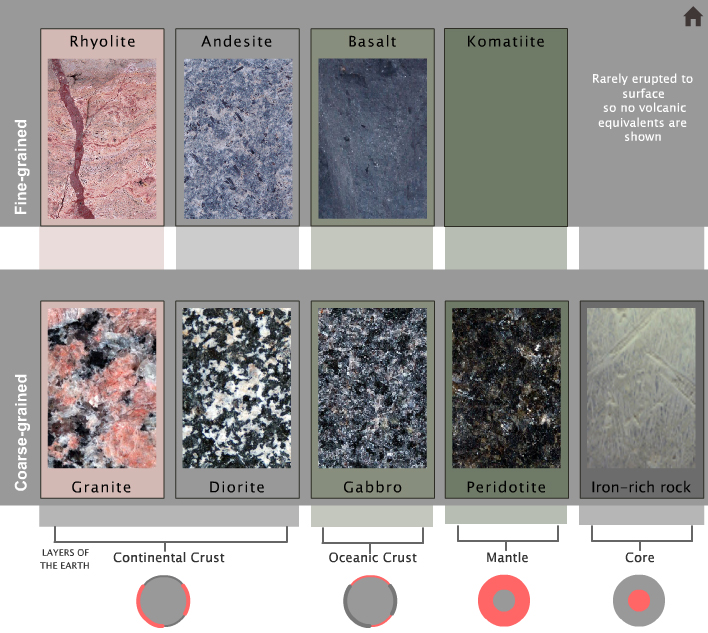
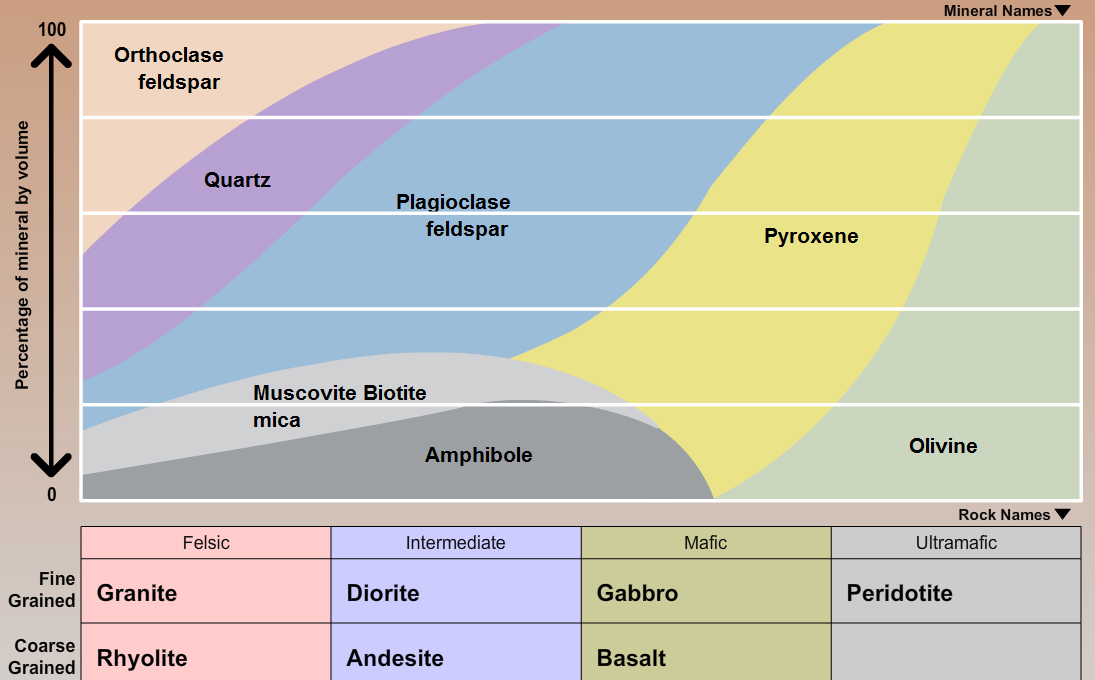
 Note to aliens:
Note to aliens:
"Guess where you can find the igneous rock andesite... the ANDES!
- the Earthlings
We've made a map showing the places where igneous rocks are common.
Igneous rocks make up much of the Earth even though the surface of the Earth is covered in many places by a thin layer of sedimentary rock.
In some places, igneous rocks are exposed at the surface because volcnoes erupt at the surface.
But dig below the surface and you'll find igneous rock everywhere because magma solidifies underground.
But in special places, even rocks that had solidified underground can be exposed at the surface. When overlying materials are eroded away or worn away, even deep buried magma chambers can be exposed.
For your science notebook:
8a. Look at the map of "Places where different types of igneous rocks are found."
Observe the places where your igneous rock might have been found. Click on the button "Igneous Rock Types" to bring up the map. You can overlay other kinds of information by clicking on other buttons.
Mark those places where your rock may have been found on your blank map by coloring in those areas. If it is a large area, use a light color so you can write over it later.
This is the first clue to where you landed. You will use two other clues to further narrow the places where you might have landed.
8b. Based on what you know about the Earth's tectonic plates, did your rock form at the boundary between plates or not?
8c. If your rock came from near a plate boundary, are the plates converging or diverging where your rock formed?
8d. Is any special tectonic activity taking place where your rock formed?

 Inside basalt
Inside basalt
